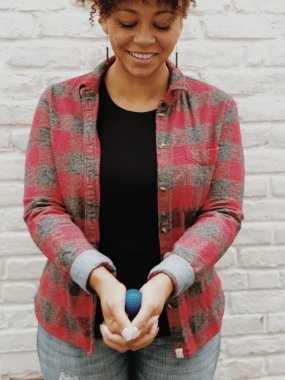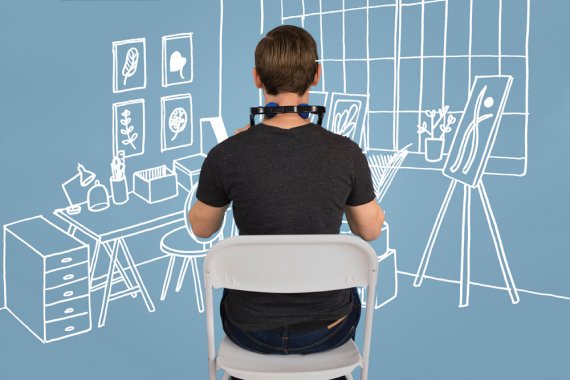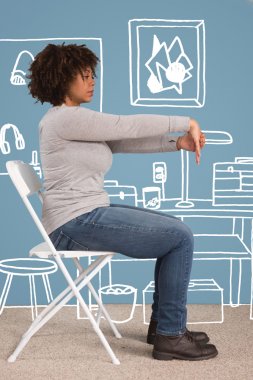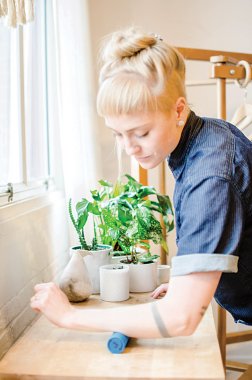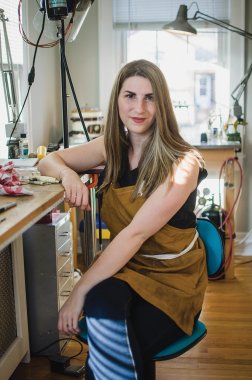Zen and the Art of Maker Maintenance
Zen and the Art of Maker Maintenance
As a jeweler, Missy Graff Ballone knows firsthand the aches and pains makers often experience; as a massage therapist (it’s how she put herself through art school) and yoga teacher, she also knows how to soothe and help prevent them. By combining her training in making and wellness, she’s helping those who work with their hands learn the nuts and bolts of self-care. Since 2015, she’s given in-person workshops, sold simple massage tools, and managed a collaborative online resource called Wellness for Makers that shares stretches, strength-building exercises, and other tricks to help artists keep their minds and bodies in optimal working condition. The New Jersey maker, 31, talked with us about the value of self-care in building a sustainable career and why practicing wellness is easier than it might seem.
Why did you start Wellness for Makers?
A few years ago, I was having a conversation with a group of artists. We were just talking about the pain that we were all experiencing in our hands and our bodies as a result of what we were practicing. And a couple of them were really accepting of the fact that we were all just going to end up with a repetitive strain injury. That was just going to be our way of life, and, eventually, we’d get older and wouldn’t be able to make, or would be making with a lot of pain.
It was really alarming to hear my peers expressing that pain and repetitive strain injuries are just something artists should accept. Instantly, I was like, “No, no, no.” I went back to my room that night and started looking for a central resource for artists, but I couldn’t find anything. I was like, “I have to create one.” As someone who has a background in wellness, I just felt a very strong responsibility to the field.
But if so many makers experience pain in the studio, is it actually preventable?
Pain isn’t necessarily a bad thing. Pain is your body’s way of telling you that there is an issue you have the opportunity to change. Pain is a signal. If we didn’t feel pain at all in our bodies, we would be in danger. So if you feel pain in your wrists, that’s your body’s way of telling you maybe you should create variety in the way that you do this thing. It’s not that you can’t do it anymore; it’s “how can you change the way you do this or add some variety to the way you do it?”
I think that, a lot of times, people feel certain pains in their bodies and just accept that [they’re] getting carpal tunnel, and there’s no way to stop it.
Or they might say, “I’m getting older.”
Or “I’m getting older, and that’s just the way that it happens; when you age, you just get a lot of pain in your body.” I disagree with that so much. Obviously, there’s only so much we can do – we all get older. But I have 70-year-olds in my yoga classes, and they’re doing handstands and being strong in their bodies, because they have a very consistent practice of taking care of themselves.
How can makers take better care of themselves in the studio?
I think that you have to create a practice that includes stretching, strengthening, massage, and variety. Creating variety in your movements is critical for maintaining the health of your hands and body. Taking time to switch tasks might sound inefficient [until makers] think about how inefficient it would be for them to be out of work for a few months because of a repetitive strain injury. A lot of times it’s like, “I have to keep making. I have to finish this order. I have to finish for this show. I have to get ready for ACC,” all of these things. They’re pushing themselves through, and they’re afraid of taking breaks.
How can makers add variety to their movements?
Rather than eliminating any movement entirely and replacing it with another, try alternating tasks. So, for example, if you sit for a majority of your day, try alternating sitting and standing. It’s not to say that standing is better than sitting, which is what a lot of the vibe is right now. It’s important to give your joints and muscles a break from staying in one position too long. Even if you’re sitting, eventually your knee joints and your legs are going to get tired, too, because they’re not getting the circulation they need.
If you stand for extended periods, remind yourself to move around the workspace and change the types of surfaces that you stand on. A lot of times, in these collaborative studio spaces, we’re standing on cement floors. How can we switch that up? Maybe [stand on] an anti-fatigue mat for part of the day. There are a lot of different types of surfaces you can choose to stand on in your studio, and that can help reduce pressure on the joints.
What about the hands?
If you’re a maker who fabricates very small objects, that process requires your hand to grip tools or the piece. Holding anything too tightly for long periods can create strain in your hands, wrists, and forearms, and ultimately create a repetitive strain injury. So loosening the grip is very important. [If your tools don’t have] ergonomic handles, I encourage wrapping them in foam padding from your local hardware store so it’s a little softer and wider; some artists get tape or medical tape.
Also, if you’re holding a tool tightly for long periods – say, it’s a jeweler sawing, and they are holding this very small saw frame for long periods – eventually, that tightens up the wrist area and your hands and fingers, and then your forearms, leading into your elbow. It’s all connected. By loosening the grip, it makes the whole movement a little bit looser and easier on the joints.
What else?
I guess the other thing to think about is just checking in with your body every 30 minutes and being consistent about that. You can set a reminder on your phone or on your computer. And it’s just a check-in time. It doesn’t mean you have to take a 30-minute break every 30 minutes. But just set a reminder to notice: Am I slouching? Am I hunching over? Am I hungry? Am I thirsty? I know that I have just ignored it, because you don’t want to get up to grab a glass of water or something to eat because you’re working so diligently. And then two hours pass by. Things like that are really critical – just listening to and respecting your body’s needs.
Taking a break can be as simple as focusing on your breath for a few moments. And that’s really great if you’re really experiencing some anxiety, like you’ve got to get this application in, you’ve got to do this, you’ve got to do that, or your piece isn’t working out the way you want it to; just taking the time to notice your breath – the sounds, feelings, and movement of it – can physically calm down your nervous system. It only takes a few moments, and it goes a long way.
Does looking down at smartphones affect our bodies?
Oh, sure. I talk about smartphones in almost all of my workshops, because we are on them so much. We’re on them promoting ourselves. We’re on them texting, communicating, calling, all these things. One of the main things that I talk about is saving our thumbs – most people depend on them to scroll and to type – because we need them so much in our making process. What I try to encourage makers to do is alternate between thumbs and fingers. Your hands will thank you.
Another tip is to lift your phone out in front of you. It’s a common tendency to hold our phones by our waists and look down, and that adds so much strain to your neck.
And then, also, just take a break from screens. Relax your eyes. We’re on our screens so much. But if you’re going to be looking at a screen for an extended time, you can set timers to look away, or just lightly massage your temples and focus on a point in the distance.
It sounds so simple. Why do so many struggle with self-care?
I think that money is part of it. Also, because we’re not educated about the body in school, we end up thinking that the only way to feel better is to get a massage or visit a chiropractor. And those are very important, but not every artist can afford them.
[People] think of wellness as a spa. They think spa, yoga, things like that. It’s important to me to educate artists on other ways of practicing self-care in the studio. Even if you are someone who can go to movement classes and get massaged, you still need self-care in your studio practice.
I also think it’s hard to make self-care a priority.
I think that’s true. It’s looked at as a luxury. And when artists are working so hard and not always getting paid what they deserve, it’s like, “I have to spend time making as much as possible, so that way, I can afford to do what I need to do.” And they might not set that time aside for themselves.
And yet, as artists, we have no problem investing in really great tools. We have no problem taking care of our tools. You want a really nice wheel, you get a really nice wheel. You need a hydraulic press, you’re going to buy a hydraulic press. You need a great loom, you’re going to get a great loom, because you want your work to be great. But your body is your most important tool, and if you don’t have it, you’re not going to be able to make. So why not invest in your body, as well?

